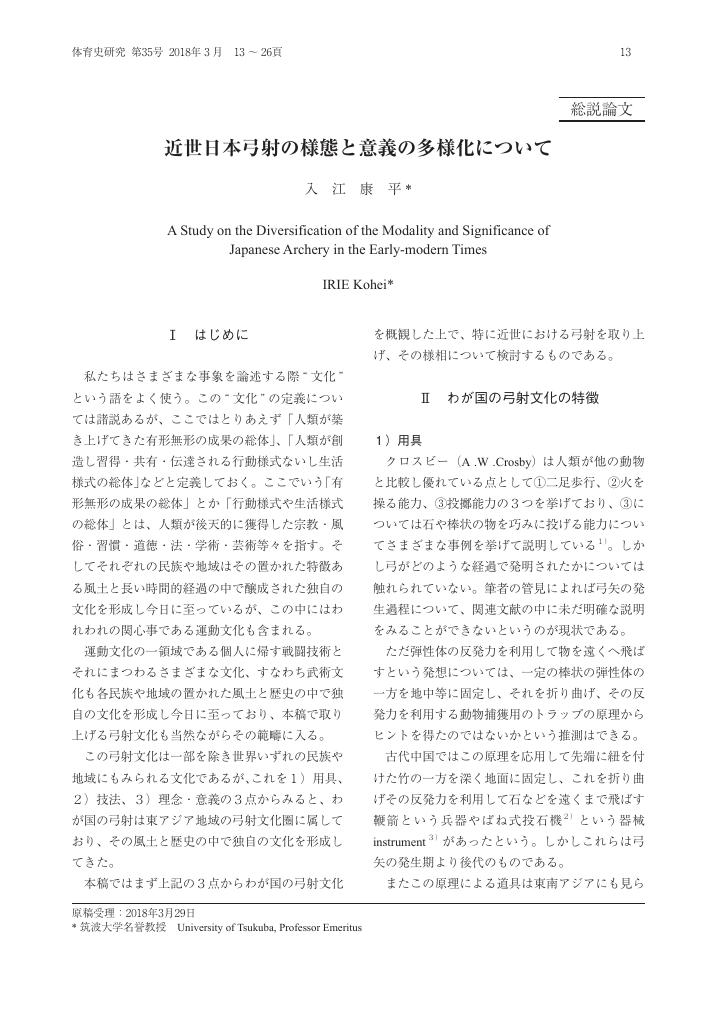40 0 0 0 OA 柔道衣の形態と色に関する史的研究(その1)
- 著者
- 藤堂 良明 入江 康平 村田 直樹
- 出版者
- 日本武道学会
- 雑誌
- 武道学研究 (ISSN:02879700)
- 巻号頁・発行日
- vol.30, no.3, pp.40-46, 1998-03-31 (Released:2012-11-27)
- 参考文献数
- 26
Recently there comes a lot of debating about Judo suit and main points are its form and colour. We tried to reserach the historical changes of Judo suit, especially about its form and colour in Japan and the results are as follows;(1) During the war pesiod, the warrior put on a HAKAMA (a divided skirt forman's for mal wear) and a KOSODE (a wadded silk garment) under the armors. After the war ended, the warrior sheds the armor and put on a HAORI (a Japanese half coat) instead of the armor on a HAKAMA and a KOSODE. The warrior wore a JUBAN (a half undergarmet) and drawers as underwears and the colour of those wears were white with the raason of low cost without dyeing.(2) When the warrior practised KATA of Jnjutsu, they took off a HAORI and so the wears for the practice were KOSODE and HAKAMA. After the KATA practice, they did MIDARE-GEIKO (a practice of free fighting style) and then took off KOSODE and HAKAMA and wore half sleeves which were made wider and quilted to make it be stronger, and the form was as the same as JUBAN. They put on MOMOHIKI (drawers) too in the practice.(3) The founder of Judo, Jigoro KANO mentioned Jude suit in his book that an upper garment could be white cotton in colour and trousers, MOMOHIKI with strings around the waist. Those which were mentioned by J. KANO are the technical terms of underwears, so that the origin of Judo suit could be recogrized as the underwears in Japanese culture. J. KANO maintained traditions of the white colour and improved of length of sleeves for prevention against injuries. And he established Dan and Kyu grading system with the various colours of the belts.(4) There has been a traditional belief among Japanese peoqle that white colour means pureness and holiness which are much worthy to the life, so that could be the reason why the white colour of Judo suit could be maintained so far.
13 0 0 0 OA 弓射における「手の内の働き」と矢の速度について
7 0 0 0 OA 武道における歴史上のとらえ方とその変遷
1 0 0 0 OA 「伊達世臣家譜」にみられる仙台藩の射手
- 著者
- 黒須 憲 入江 康平
- 出版者
- 日本武道学会
- 雑誌
- 武道学研究 (ISSN:02879700)
- 巻号頁・発行日
- vol.28, no.Supplement, pp.64, 1995 (Released:2012-11-27)
1 0 0 0 OA 近世日本弓射の様態と意義の多様化について
- 著者
- 入江 康平
- 出版者
- 体育史学会
- 雑誌
- 体育史研究 (ISSN:09144730)
- 巻号頁・発行日
- vol.35, pp.13-26, 2018 (Released:2022-09-18)
1 0 0 0 OA 「弓道要則」の成立とその背景について
- 著者
- 入江 康平
- 出版者
- 日本武道学会
- 雑誌
- 武道学研究 (ISSN:02879700)
- 巻号頁・発行日
- vol.5, no.1, pp.9, 1972-10-30 (Released:2012-11-27)
- 被引用文献数
- 1
1 0 0 0 OA 弓道における遠矢に関する研究
1 0 0 0 OA 江戸時代における武術関係刊行物の研究―特に弓射関係書の動向について―
- 著者
- 入江 康平
- 出版者
- 日本武道学会
- 雑誌
- 武道学研究 (ISSN:02879700)
- 巻号頁・発行日
- vol.17, no.3, pp.8-17, 1985-03-30 (Released:2012-11-27)
- 参考文献数
- 8
The technical system of martial arts in Japan had been established in the 16 th and 17 th centuries and various schools of them had been founded. In the area of archery, the transmission system of technical method in mounted and ceremonial archery, which were characterized as the chivalrous accomplishments, had been established in the 15 th century. On the other hand, foot soldier archery (Hosha), which aimed at the real battle, was developed toward the same direction as those of another martial arts.In the Edo period, the publishers, which had become one of the established business, printed, published, and made public the texts of martial arts which had hitherto been secret.Archery, strategy, and gunnery were the main categories of martial arts in terms of the number of publishing. Many works on strategy and gunnery had been published after the 19 th century, assumedly because of the influence of advanced military techniques introduced by the European countries.As for the works concerned with archery;1. The arrival of firearms in the 16 th century and the accompanied changes in the warfare methods made decrease the utility of the bow. Thereafter, archery was emphasized with its traditional and ceremonial aspects.2. Archery started to be recognized as the chivalrous accomplishments being a part of general education of a Bushi.3. Competitive aspect of archery (e. g. Toshiya) raised the interest among the vast majority. These factors might have facilitated the publication of texts dealing with archery.





